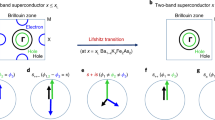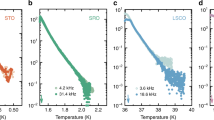Abstract
Movshovich et al. suggest that our calorimetric observation of the FFLO superconducting phase boundary1 and its angular dependence are inconsistent with their own data reporting the possible presence of an FFLO phase, and that we have incorrectly used magnetothermal measurements to identify the order of the FFLO transition. They also contest that the correlation of the magnetization steps with the calorimetrically identified FFLO superconducting phase of CeCoIn5 is coincidental. We consider each of these points in turn.
Similar content being viewed by others
Radovan et al. reply
First, our calorimetrically determined FFLO phase boundary is in fact in good agreement with their own phase diagram2 for H∥[110] and with their earlier calorimetric data3 reporting the absence of an FFLO phase transition for H∥[001] down to 0.1 K. In addition, our measurements of the variation of Cp with field — data used to determine the location of the FFLO and Hc2 superconducting phase boundaries — agree with new measurements4 at 0.5 K for H∥[110] and with earlier work5 at 0.25 K and 0.8 K for H∥[001]. Because our specific-heat measurements only extend down to 0.15 K, we are unable to address the merits of their revised report2 of a possible FFLO phase transition at 0.13 K for H∥[001].
Second, the determination of the second-order nature of the FFLO phase boundary from the absence of a detectable heat pulse in the magnetothermal data presented in ref. 1 for 0.25 K is also in good agreement with the results in ref. 2. As the first-order nature of the Hc2 transition at that temperature has already been established3,6, the temperature changes at the transition can be identified as the release and absorption of latent heat. Although our determination of a change in the order of Hc2 at T0=1.25±0.15 K for H∥[110] contradicts the originally inferred value6 of 0.7 K, it is in increasingly good agreement with more recent values2 of 1.0 K for H∥[100] and 1.1 K for H∥[110].
Third, decreasing the angle, Θ, between the applied field and the superconducting layers at constant external field reduces the value of the field component normal to the layers, B⊥. This in turn decreases the Landau-level spacing and allows the order parameter to assume higher states, m, for a given FFLO wavevector, Q=Q(B). In our case, however, the data were obtained by increasing the field at constant angle. If the total induction remained constant, the Landau index would then decrease in an increasing field. However, the FFLO wavevector also changes with each step, precluding prediction of the optimal Landau index at a given field at the present time.
A full treatment would require consideration of large effective masses, spin–orbit coupling, g-values7 and the spatial variation in the magnetic flux (that is, finite Ginzburg–Landau parameter, κ). To our knowledge, the first work implementing some of these effects is given in refs 8, 9, but CeCoIn5 displays a first-order rather than a second-order phase transition at the critical field, and it is not clear how this affects these predictions for the Landau-level quantization. We have already proposed a method of incorporating strong electron–electron coupling and many-body effects to account for the experimentally determined Pauli limit1.
References
Radovan, H. et al. Nature 425, 51–55 (2003).
Bianchi, A. et al. Phys. Rev. Lett. 91, 187004 (2003).
Bianchi, A. et al. Phys. Rev. Lett. 89, 137002 (2002).
Aoki, H. et al. J. Phys. Cond. Mat. 16, L13–L19 (2004).
Ikeda, S. et al. J. Phys. Soc. Jpn 70, 2248–2251 (2001).
Tayama, T. et al. Phys. Rev. B. 65, 180504 (2002).
Won, H. et al. Preprint at 〈http://xxx.lanl.gov/cond-mat/0306548〉 (2003).
Klein, U. Preprint at 〈http://xxx.lanl.gov/cond-mat/0312095〉 (2003).
Klein, U., Rainer, D. & Shimahara, H. J. Low Temp. Phys. 118, 91–104 (2002).
Author information
Authors and Affiliations
Corresponding author
Rights and permissions
About this article
Cite this article
Radovan, H., Fortune, N., Murphy, T. et al. Magnetic enhancement of superconductivity. Nature 427, 802 (2004). https://doi.org/10.1038/427802b
Issue Date:
DOI: https://doi.org/10.1038/427802b
This article is cited by
-
Vortex lattices in type-II superconductors studied by small-angle neutron scattering
Frontiers of Physics (2011)
Comments
By submitting a comment you agree to abide by our Terms and Community Guidelines. If you find something abusive or that does not comply with our terms or guidelines please flag it as inappropriate.



